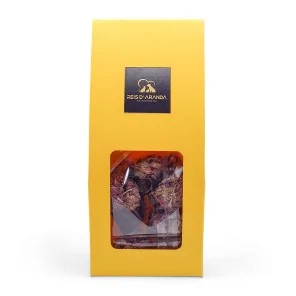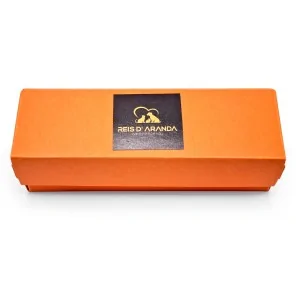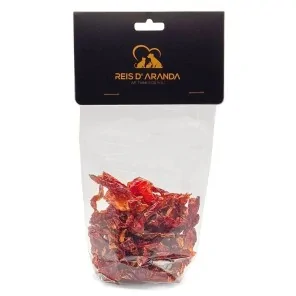The Tornjak originated from genetically homogeneous, almost extinct, indigenous shepherd dogs. These dogs have...
THE DWARF "LIONHEAD" RABBIT
The Lionhead is a breed of dwarf rabbit that carries the gene for dwarfism and is particularly popular in the UK and USA, where it is fighting for recognition of a greater number of colours and colour patterns within its association (ARBA).
A sweet and sociable breed, ideal for those who like to groom but cannot commit to more extensive grooming breeds such as the Teddy Dwerg, Teddy Lop or Angoras.
THE ORIGIN OF THE LIONHEAD RABBIT
The Lionhead rabbit originates from France and Belgium, although it is not recognised by the French Rabbit Federation. It is said to have been produced by breeders attempting to breed a dwarf long-haired rabbit by crossing a Mini Swiss Fox and a Netherland Dwarf. The result was a genetic mutation that caused wool to appear around the head and on the flanks. This gene is known as the "mane" gene. There are many other reports similar to this, for example, that the Lionhead has been bred from a Netherland Dwarf and a Jersey Wooly, but none have been substantiated, as the mane gene is independent of the gene that creates woolly coats in woolly rabbits. The Lionhead rabbit continued to gain popularity in Europe and arrived in the United States in the late 1990s.
In the UK, the BRC has recognised the Lionhead breed since 2002.
In 2013, the ARBA accepted the Lionhead as a recognised breed in two varieties: Tortoise and Ruby-Eyed White.[5] As of 1 February 2014, Lionheads can compete for Best in Show and receive paws towards Grand Champion.
The North American Lionhead Rabbit Club (NALRC) holds its annual Lionhead Specialty show in Columbus, Ohio. Typically, the Lionhead breed is represented by approximately 300-500 entries and 50-80 exhibitors from across the United States and Canada.
As far as Spain is concerned, the breed was recognised by the Spanish Association of Dwarf Rabbit Breeders (AECCE) and the National Association of Family Rabbit Breeding (ASNAC) in 2012 and 2013 respectively, although there are currently no breeders in Spain that are dedicated to this wonderful breed, with the Teddy Dwerg being more popular.
THE LIONHEAD RABBIT STANDARD
Next, we will see the breed regulations (standard) which is applied within AECCE and ASNAC, which is governed by the UK standard.
1. TYPE: The body of this rabbit should be short, compact and well defined. The chest and back should be broad and full, well boned and well muscled. The hindquarters should be broad, deep and well muscled, firm to the touch.
The head should be rounded with good width between the eyes. The muzzle should be long and well developed, the head should be close fitting to the body with no visible neck. Legs: of medium size with good bone structure, not thin. They should be of sufficient length to show the mane and chest.
The ears should not exceed 7.5 cm (between 5.5 - 7.5 cm), should be erect and open, well covered with hair, but not as much as in the Angora breed. They should be balanced, maintaining proportion and harmony with the head and the rest of the body.
The eyes should be round, protruding and bright. White rabbits should have ruby or blue eyes. In other colours, the eye colour according to the colour of the animal's coat according to the normal colour pattern. White mist in the eye (cataracts) is not permitted.
2. MANE: The hair of the mane should be between 5 and 7 cm in length, extending from the back of the neck in a V-shape, falling in a fringe around the head, with more hair on the chest forming a bib.
3. HAIR: The coat should be dense, of medium length (not sparse) with direction of growth from head to hindquarters, always of equal length, often with a fine line of hair bounding the hindquarters towards the groin. A small amount of hair on the flanks is permissible in dogs aged 5 months or less.
4. COLOUR: Any colour or pattern accepted by the Breed Standards Committee of the British Rabbit Council. It is important to remember that the colour of the mane must be the same as the colour of the undercoat in that area.
The Vienna Marked (VM) is not permitted.
5. CONDITION - The dog should be in perfect health and good physical condition, free from any dirt, especially on legs, ears and sexual organs, with no knots in the Malena. The coat should reflect the general good health of the dog, which should appear alert and vigorous.
FAULTS - Long narrow head, pointed or weak muzzle. Long and narrow body, short or lowered hindquarters, any specimen showing lack of type. Ears too long, mane short or sparse in appearance, hair too long on the skin of the flanks.
DISQUALIFICATIONS - Dental malocclusion, absence of mane or chest hair, hair on top of ears, cataracts (walleye), white patches on nose or putty nose, unpigmented or incorrectly coloured nails. Adult weight over 1,700 kg, obvious signs of anorexia, obesity or abuse/neglect.
THE MANE OF THE LIONHEAD
The Lionhead's mane is what most represents him and also gives him his name, but first we must know that there are 3 types of manes within the Lionhead:
- NO MANE (NM / mm): These are rabbits of the Lionhead breed whose physical appearance does not differ from that of a common rabbit, as they do not have a mane of any kind. This variety is not bred and the only thing which recognises them as "Lionhead" is the "pet" pedigree which accompanies them from their breeder's home together with the microchip, tattoo or ring. A pet pedigree (minimum 4 generations) states that the animal is not suitable for breeding and must be neutered at 5 months of age.
- SINGLE MANE (SM / Mm): The Lionhead SM is less used in breeding but is essential to avoid the appearance of "fluffys" (Lionheads with precisely long hair, where the "saddle" which is the short-haired part of the back, disappears and they resemble the Teddy Dwerg). Their manes are a bit shorter and less bushy than the "Lionhead DM".
- DOUBLE MANE (DM / MM): The most popular Lionhead of all, with abundant, long and showy manes. They are the most commonly seen in shows and require more grooming than the "SM".
How do the genetics work when crossing them?
- "NO MANE" X "NO MANE": 100% "NO MANE".
- "NO MANE" X "SINGLE MANE": 50 "NM" / 50% "SM".
- "NO MANE" X "DOUBLE MANE": 100% "SM".
- "SINGLE MANE" X "NO MANE": 50% "SM" / 50% "NM": 50% "SM" / 50% "NM".
- "SINGLE MANE" X "SINGLE MANE": 25% "SM" / 25% "NM" / 25% "DM": 25% "SM" / 25% "NM" / 25% "DM".
- "SINGLE MANE" X "DOUBLE MANE": 50% "SM" / 50% "DM" / 25% "NM" / 25% "DM".
- "DOUBLE MANE" X "NO MANE": 100% "SM" / 100% "NM" / 100% "DM".
- "DOUBLE MANE" X "SINGLE MANE": 50% "SM" / 50% "DM": 50% "SM" / 50% "DM".
- "DOUBLE MANE" X "DOUBLE MANE": 100% "DM".
LIONHEAD, TEDDY DWERG OR ANGORA? WHAT'S THE DIFFERENCE?
Some people get confused here, but although there are many mongrels disguised as Lionheads or Angoras, we are going to start from the basis of three purebred rabbits, with their individual identification (microchip, ring or tattoo) and pedigree endorsed by a national or international club (which is the only thing that determines the breed of a rabbit).
- TEDDY DWERG: The Teddy Dwerg has long hair all over the body, with a length of 10cm and ears of 4cm. He admits all existing colours, mixtures and patterns, his coat is a mixture of two genes: the wool (L) and the mane (M). Its adult weight is 800gr-1,350kg.
It should not be sheared.
- THE ANGORA: It has 5 sub-breeds, each with a specific standard and characteristics (including the distribution of the coat and the accepted colours). It does not have hair as such, but wool with only one gene (100% L gene), it must be sheared every 2-3 months by machine.
- LIONHEAD: Its ears do not exceed 7.5cm, it has a mane and saddle (short hair back), when adult it does not exceed 1.750kg and should not be sheared.
SPECIFIC CARE OF THE LIONHEAD RABBIT
The care of the "Lionhead" is centred solely on the necessary brushing so that the mane is in good condition and does not form knots or suffer from skin problems because of this; the brushing should be much more frequent in the "Lionhead DM" using an extra long barbed butter brush, a moisturising styling spray and a metal comb.
THE PERSONALITY OF THE LIONHEAD DWARF RABBIT
The "Lionhead" is a playful and affectionate breed, they love to explore and jump, but at the same time they know how to behave when they have to (especially when brushing). It is essential to get them used to handling and grooming sessions, especially when grooming complex areas such as the chest, armpits or hindquarters.
Leave a comment
Log in to post comments
Comments
Cabeza de león
By: Jeremy On 05/02/2024Yo tengo uno, se llama Oliver
The super Lionhead
By: Holly Rose On 05/02/2024The Lionhead is my favourite breed of rabbits, my parents have been keeping them for a few years now and I have started too, my favourites are the REW and the agouties.
















